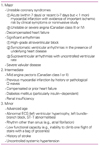Abstract
Perioperative myocardial infarction is a major cause of morbidity and mortality in patients who undergo non-cardiac surgery, while an increasing number of patients with a coronary artery disease are presenting for surgery. In order to cope with this problem, one should first evaluate risk factors of these complications, and then manage the patient at risk to reduce or eliminate the risk factors. Risk assessment evaluates patients' co-morbidities and exercise tolerance, as well as the type of surgery to be performed, to determine the overall risk of perioperative cardiac complications. Previous or current cardiac disease, diabetes, and renal insufficiency all confer higher risks for perioperative cardiac complications. Poor exercise tolerance and high-risk surgical procedures (e.g., vascular, prolonged thoracic, or abdominal operations) also predict worse perioperative outcomes. Stress testing should be reserved for patients at moderate to high risk undergoing moderate- or high-risk surgery and those who have poor exercise capacity. After the assessment of the risk of cardiac complications, one should take measures to reduce it, including medical therapy and coronary intervention. Medical therapy using beta blockers, statins, and alpha-2 agonists may be effective to reduce perioperative risk and to obviate the need for more invasive procedures in high-risk patients. Coronary intervention should be performed for those patients who are indicated independent of the non-cardiac surgery. There appears to be no single best myocardium-protective anesthetic management, and therefore, the choice of anesthesia and intraoperative monitors is left at the discretion of the anesthesia care team.
Figures and Tables
Table 1
Clinical Predictors of Increased Perioperative Cardiovascular Risk (Myocardial Infarction, Heart Failure, Death)

ECG: electrocardiogram
*Adapted from ACC/AHA guideline update for perioperative cardiovascular evaluation for noncardiac surgery(4).
Table 2
Estimated Energy Requirements for Various Activities*

MET: metabolic equivalent.
*Adapted from ACC/AHA guideline update for perioperative cardiovascular evaluation for noncardiac surgery(3).
Table 3
Cardiac Risk* Stratification for Noncardiac Surgical Procedures

*Combined incidence of cardiac death and nonfatal myocardial infarction.
†Do not generally require further preoperative cardiac testing.
*Adapted from ACC/AHA guideline update for perioperative cardiovascular evaluation for noncardiac surgery(3).
References
1. Fleisher LA, Eagle KA. Clinical practice. Lowering cardiac risk in noncardiac surgery. N Engl J Med. 2001. 345:1677–1682.
2. Flood C, Fleisher LA. Preparation of the cardiac patient for noncardiac surgery. Am Fam Physician. 2007. 75:656–665.
3. Eagle KA, Berger PB, Calkins H, Chaitman BR, Ewy GA, Fleischmann KE. ACC/AHA guideline update for perioperative cardiovascular evaluation for noncardiac surgery-executive summary: a report of the American College of Cardiology/American Heart Association Task Force on Practice Guidelines (Committee to Update the 1996 Guidelines on Perioperative Cardiovascular Evaluation for Noncardiac Surgery). J Am Coll Cardiol. 2002. 39:542–553.
4. Fleisher LA, Beckman JA, Freeman WK, Brown KA, Froehlich JB, Calkins H. ACC/AHA 2006 guideline update on perioperative cardiovascular evaluation for noncardiac surgery: Focused update on perioperative beta-blocker therapy. J Am Coll Cardiol. 2006. 47:2343–2355.

5. Older P, Hall A, Hader R. Cardiopulmonary exercise testing as a screening test for perioperative management of major surgery in the elderly. Chest. 1999. 116:355–362.

7. Stone JG, Foex P, Sear JW. Risk of myocardial ischaemia during anaesthesia in treated and untreated hypertensive patients. Br J Anaesth. 1988. 61:675–679.

8. Eagle KA, Guyton RA, Davidoff R, Ewy GA, Fonger J, Gardner TJ, Gott JP, Herrmann HC, Marlow RA, Nugent W, O'Connor GT. ACC/AHA guidelines for coronary artery bypass graft surgery: executive summary and recommendations. A report of the American College of Cardiology/American Heart Association Task Force on Practice Guidelines (Committee to revise the 1991 guidelines for coronary artery bypass graft surgery). Circulation. 1999. 100:1464–1480.

9. Eagle KA, Rihal CS, Mickel MC, Holmes DR, Foster ED, Gersh BJ. Cardiac risk of noncardiac surgery: influence of coronary disease and type of surgery in 3368 operations. CASS Investigators and University of Michigan Heart Care Program. Coronary Artery Surgery Study. Circulation. 1997. 96:1882–1887.
10. Smith SC Jr, Dove JT, Jacobs AK, Kennedy JW, Kereiakes D, Kern MJ, Kuntz RE, Popma JJ, Schaff HV. ACC/AHA guidelines of percutaneous coronary interventions (revision of the 1993 PTCA guidelines)-executive summary. A report of the American College of Cardiology/ American Heart Association Task Force on Practice Guidelines (committee to revise the 1993 guidelines for percutaneous transluminal coronary angioplasty). J Am Coll Cardiol. 2001. 37:2215–2238.

11. Yoo KY, Yang SY, Lee J, Im WM, Jeong CY, Chung SS, Kwak SH. Intracoronary propofol attenuates myocardial but not coronary endothelial dysfunction after brief ischaemia and reperfusion in dogs. Br J Anaesth. 1999. 82:90–96.

12. Yoo KY. Ischemia-reperfusion injury and anesthesia. Korean J Anesthesiol. 2007. 52:499–510.




 PDF
PDF ePub
ePub Citation
Citation Print
Print


 XML Download
XML Download